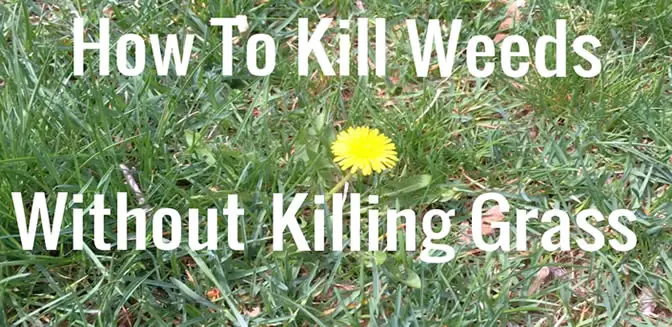Lawn care is, for the most part, a relaxing and beneficial activity. However, when you are faced with a lawn full of weeds it can fast become a daunting and stressful task when you don’t even know where to start.
Table of Contents
How to get rid of a lawn full of weeds
Although it can seem like a daunting task it is actually relatively easy to remove weeds from a lawn regardless of how many have taken up residence there.
There are proven methods for removing weeds without the need to rely on harmful herbicides.
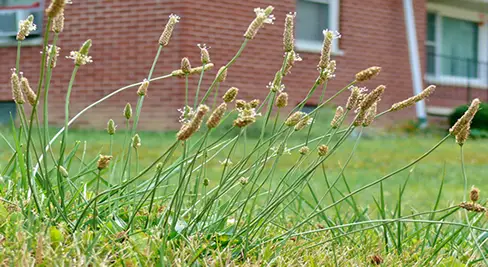
There are also organic weed killers that can quickly kill these growing pests without harming grass or wildlife.
Using chemical herbicides should be a last resort as there is mounting evidence that they are harmful to the environment and wildlife such as bees.
Let’s take a look at some of the best organic ways to totally de-weed your garden safely and quickly.
The 3 simple steps to deweed a lawn
Here are the 3 simple steps you need to follow to deweed a lawn full of weeds.
Dethatch the lawn.
Aerate the soil.
Spray the treated soil with weed killer.
Simply spraying weed killer over the weeds will not get rid of them permanently and it will also kill your grass and plants.
Each of the above steps are necessary if you want to ensure the weeds do not return.
Equipment you will need to deweed a lawn
Before you start there is some equipment that you will have to buy or borrow to de-weed your lawn.
These are relatively inexpensive items.
The 4 items you will need to get rid of weeds on your lawn:
With these handy items you will be able to eliminate weeds from your garden in record time.
A scarifier is the first step to getting rid of weeds
A scarifier is a fancy name for a dethatcher.
Often when we have a lot of weeds in the garden there will also be a thatch build-up.
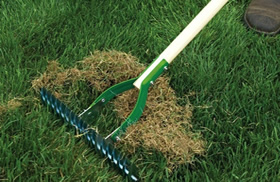
By dethatching the lawn you will not only remove the thatch but pull up a lot of the pesky weeds as well, making it easier to apply your de-weeding treatment.
Thatch-build creates a thick layer of organic living and dead material that stops water and nutrients from reaching the roots of grass and other garden plants.
This creates the perfect environment for shallow rooted weeds to thrive as they have no competition for resources.
Using a Scarifier or thatch rake is the fastest and easiest way to dethatch your lawn.
You can read more about dethatching here.
An aerator is also necessary for deweeding
When you have thatch-build up on your lawn scarifying/dethatching it is only half of the necessary work you must do.
Compacted soil and thatch build-up form a tough layer that prevents water and nutrients from reaching the deeper parts of the turf to feed grass roots – much like thatch build-up does.
This leads to dry and dead patches over the lawn and dull unhealthy looking grass.
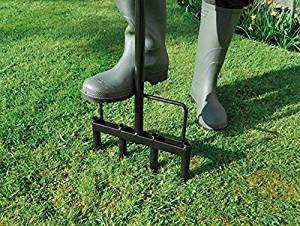
After dethatching you would normally aerate your lawn to allow water and nutrients to more easily pass down the turf layers to the roots of grass.
However, as you have a weed problem to tackle you will de-weed the lawn first and only after you have dealt with that problem should you aerate.
Although most modern weed killers claim to do no harm to grass and actually help feed the roots just to be on the safe side it is best to keep the roots protected while you kill the weeds.
Aerators come in all shapes and sizes and range from the very cheap to the more expensive machine powered models some of which are very expensive
.
Weed killer is needed to finish the weeds off
The best type of weed killer is a combined feed and weed killer treatment that is environmentally-friendly.
It has been shown that avoiding herbicides and using organic weed killer can help bee populations to recover.
Although Monsanto products, such as Roundup, seem to be very effective there are studies that suggest it is connected to bee deaths so I stay away from anything this company produces.
Likewise I try to keep garden products as organic in nature as I possibly can.
A good organic weed killer will still target grassy weeds such as (but not limited to) dandelions, clover, chickweed and crabgrass and free your garden of these pests while leaving the rest of the environment unharmed.
Once you have treated the weed problem and your lawn is in good shape you should consider using a organic weed preventer so you don’t encounter this problem again.
And you can also use mulch to further prevent weed build up.
A weed killer sprayer is the fastest, most effective way to distribute the weed killer
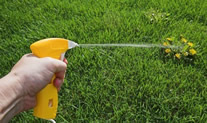 Using a weed killer sprayer
Using a weed killer sprayer bottle is the best way to apply weed killer no matter what kind you are using.
Although organic weed killer is a lot safer and much more desirable to use it is still a good idea to keep it away from healthy areas of your lawn.
Modern spray bottle are very accurate and using one means you can target individual weeds without effecting the surrounding area.
They are also very cheap.
Instructions for removing weeds from a lawn
You can de-weed your lawn in a few simple steps as outlined below.
Dethatch the lawn to prepare it for deweeding
Start by de-thatching your lawn with a scarifying rake.
This will remove not only thatch but also the top layer of weeds.
You can also use a weeding tool after dethatching (optional)
 Consider using a specialist weed tool such as the Garden Weasel
Consider using a specialist weed tool such as the Garden Weasel.
Tools like this make it easy to remove weeds like dandelions at the their roots without the need to stoop down.
Simply, step on the tool, twist it and then pull to remove the weed from its roots.
Doing this can greatly speed up the de-weeding process as you can eliminate between 80% to 90% of the weeds before you even apply weed killer.
This also makes clearing out the dead weeds a much easier easier task as there will not be as many of them.
Additionally you can use the tool to remove dead weeds.
De-weeding by hand is one of the most effective ways of dealing with weeds on your lawn.
If you have time to do this I highly encourage you to do so.
Unless you have a severe weed problem weeding by hand will probably eliminate the problem entirely without the need for weed killer.
Spray weed killer over the entire lawn
For many people using weed killer is a last resort.
I agree with this point because most people use extremely harmful chemical herbicides to treat weeds.
As I mentioned above Roundup is a very popular, and I hate to say, very effective weed killer but unfortunately it is also linked to bee deaths.
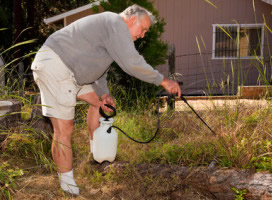 So, for this reason avoiding weed killers is always a good idea.
So, for this reason avoiding weed killers is always a good idea.
However, there are much less harmful types of weed killers that use more environmentally-friendly ingredients and that can actually help fed your grass at the same time they attack weeds.
If you can de-weed your lawn without the use of weed killer then by all means you should do so.
But, if the job is too big and demanding then be sure to use an ethically sound and environmentally-friendly weed killer.
Using a spray can spray the remaining weeds directly with the feed and weed killer combo mentioned above.
Using a weed sprayer will greatly increase your job completion time while also allowing you to only target specific areas of your lawn.
With a sprayer you can attack only the weed and leave the surrounding area completely untouched.
Only after you have successfully de-weeding your lawn should you aerate it.
Aerate the lawn soil for healthier grass and/or plant growth
Now that the lawn is clear of weeds and thatch you should aerate it using a core aerator not a spiked one.
There are very good reasons for this.
Aeration will allow nutrients and water to get deeper down into the turf where the grass roots are.
At this point you can also overseed that lawn to ensure it has no patchy areas.
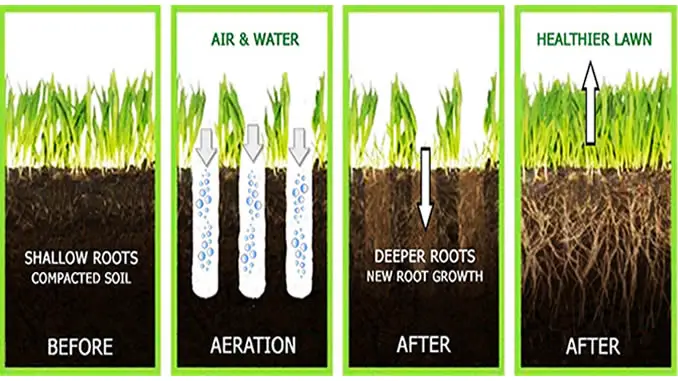
After this you can fertilize the lawn as long as you are in season.

